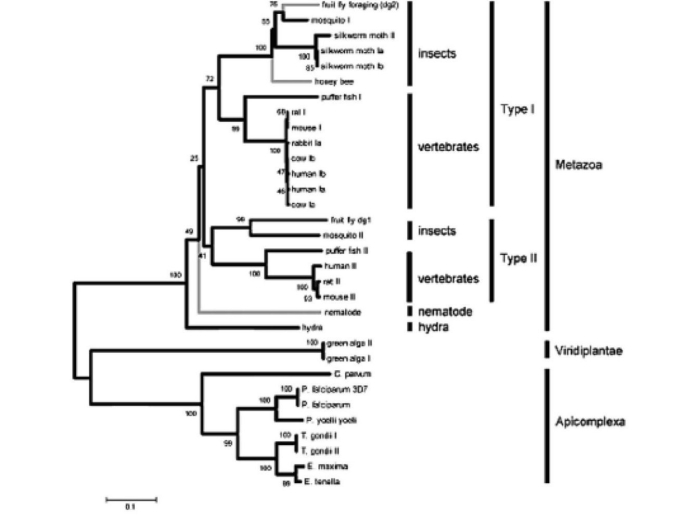Figure 51.6
Use the following information and Figure 51.6 when answering the corresponding question(s) .
The following are an abstract and figure from a paper that explores the evolutionary relationship between a protein kinase and behavior (M.Fitzpatrick and M.Sokolowski.2004.In search of food: Exploring the evolutionary link between cGMP-dependent protein kinase (PKG) and behavior.Integrative and Comparative Biology 44:28-36) .
Abstract:
Despite an immense amount of variation in organisms throughout the animal kingdom many of their genes show substantial conservation in DNA sequence and protein function.Here we explore the potential for a conserved evolutionary relationship between genes and their behavioral phenotypes.We investigate the evolutionary history of cGMP-dependent protein kinase (PKG) and its possible conserved function in food-related behaviors.First identified for its role in the foraging behavior of fruit flies,the PKG encoded by the foraging gene had since been associated with the maturation of behavior (from nurse to forager) in honey bees and the roaming and dwelling food-related locomotion in nematodes.These parallels encouraged us to construct protein phylogenies using 32 PKG sequences that include 19 species.Our analyses suggest five possible evolutionary histories that can explain the apparent conserved link between PKG and behavior in fruit flies,honey bees and nematodes.Three of these raise the hypothesis that PKG influences the food-related behaviors of a wide variety of animals including vertebrates.Moreover it appears that the PKG gene was duplicated some time between the evolution of nematodes and a common ancestor of vertebrates and insects whereby current evidence suggest only the for-like PKG might be associated with food-related behavior.

Neighbor joining trees depicting the evolutionary relationships of 32 PKG kinase domain and C-terminal amino acid sequences spanning 19 species of protozoans and metazoans.Values at the nodes represent the results of 5000 bootstrap replications.Lineages with known behavioral links with PKG are indicated by gray branches.
-Using Figure 51.6 and the accompanying paragraph,and knowing that the PKG encoded by the foraging gene has recently been associated with the maturation of out-of-nest behavior in honeybees,what would be a logical explanation for this relationship?
Definitions:
Premium on Bonds Payable
An amount by which a bond's selling price exceeds its face value, indicating that the bond was issued at a price higher than its nominal value.
Straight-Line Method
A method of calculating depreciation of an asset, where the cost of the asset is evenly divided over its useful life.
Bond Premium
The surplus of a bond's market price over its nominal or face value.
Face Amount
The total amount of money that will be paid at maturity by a financial instrument such as a bond or life insurance policy.
Q1: A pied kingfisher in its first year
Q2: Based on the data in Figure 50.3,which
Q4: Human tissue is composed primarily of:<br>A)water<br>B)air<br>C)ions<br>D)toxins
Q7: Identify the source-to-film distance (FFD)which produces the
Q7: Compared to D-speed film, the reduction of
Q14: In Figure 53.9,which community has the highest
Q16: Describe the event when x-ray photons directly
Q17: Why is it more difficult to obtain
Q27: In Figure 53.3,which species is the stronger
Q29: Your doctor takes a urine sample and